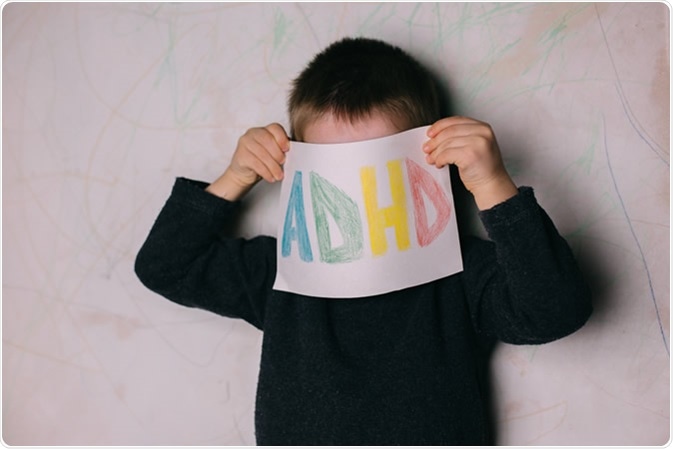Skip to:

Image Credit: Rustam Shaimov / Shutterstock
Attention Deficit Hyperactivity Disorder (ADHD) is a psychological condition thought to affect approximately 3-7% of school-aged children in the United States. It is characterized by deficits in hyperactivity, impulsivity and inattention, which present over a range of clinical features.
Research has shown that boys are three times more likely to receive a diagnosis of ADHD than girls. While girls symptoms are often subtle and therefore harder to identify, but this difference is also thought to be due to poor use of diagnostic criteria and the expectation that boys are more likely to have ADHD. As it is diagnosed in childhood, and symptoms may improve with time, the prevalence is higher in children than adults.
ADHD Symptoms and Characteristics in Children
The fifth edition of The Diagnostic and Statistical Manual for Mental Disorders (DSM 5), groups symptoms for ADHD in children into two categories.
Inattention
- Easily distracted.
- Does not listen when spoken to.
- Does not follow through on instructions given.
- Often make careless mistakes.
- Difficulty paying attention to tasks.
- Avoidance of tasks that require mental effort.
- Forgetfulness.
- Loses things needed for activities and tasks.
- Difficulty organizing activities and tasks.
Hyperactivity and Impulsivity
- Often fidgets or squirms in seat.
- Difficulty waiting for their turn.
- Often blurts out answers before a question has been fully asked.
- A habit of interrupting others.
- Often gets up when asked to remain seated.
- Talks excessively.
- Often climbs or runs in inappropriate situations.
- Difficulty taking part in activities quietly.
- Is often “on the go”.
How is ADHD Diagnosed?
Using the DSM 5, a psychologist or psychiatrist will review the symptoms presented by the child. In order for a child under 16 years-old to be diagnosed with ADHD a minimum of six symptoms of inattention and/or hyperactive/impulsivity must be present, and these must be inappropriate for their development level, and present for at least six months.

Image Credit: Billion Photos / Shutterstock
In addition to these symptoms, the following criteria must be met to diagnose ADHD:
- A proportion of symptoms must be displayed in two or more settings, such as at home and school.
- Symptoms must significantly impact the child’s quality of life.
- A proportion of hyperactive-impulsive or inattention symptoms must be experienced before the age of 12.
- Symptoms are not better attributed to other psychological disorders such as Personality Disorders and do not only occur during psychotic or schizophrenic episodes.
Depending on the combination of symptoms present, children will be diagnosed with one of three presentations of ADHD.
Combined Presentation
If the criterion for inattention and hyperactivity-impulsivity are met.
Predominantly Inattentive Presentation
If the criterion for inattention is met, but hyperactivity-impulsivity is not met.
Predominantly Hyperactive/Impulsive Presentation
If the criterion for hyperactivity-impulsivity is met, but inattention is not met.
In addition to collecting ADHD symptoms, the therapist will take a detailed medical history in order to identify the presence or absence of other psychological disorders. They will also examine the child’s medical and developmental history to rule out any medications or medical conditions that could exacerbate, predispose or mimic the ADHD symptoms in the child.
Information may also be gathered from teachers regarding the nature of hyperactive/impulsive and/or inattentive symptoms in the classroom. Questionnaires and rating scales such as the Conners’ Rating Scales-Revised may be completed by caregivers and teachers to provide objective data to confirm the diagnosis.
I have ADHD, What is Your Superpower? | Negar (Nikki) Amini | TEDxWPI
Causes of ADHD
Research has suggested a range of genetic, non-genetic and environmental causes of ADHD.
Role of Neurotransmitters
Due to the effectiveness of medications such as psychostimulants and noradrenergic tricyclics drugs in treating ADHD symptoms, dopamine and noradrenaline neurotransmitters are thought to play a role in the disordered physiological processes that accompany the syndrome.
Neurological Differences
Differences in the activation of the prefrontal and frontal regions of the brain have been found in those with ADHD. These areas of the brain play a role in the regulation of behavior, in particular impulsivity.
Traumatic Brain Injury
Damage to the prefrontal and frontal lobes of the brain can cause a deficit in executive function which can lead to issues with impulsivity and a lack of behavioral regulation often seen in those with ADHD.
Genetics
Family and twin studies have demonstrated that ADHD might have a genetic link. One study found that having a sibling or family with ADHD meant you were two to eight times more likely to develop the disorder.
Other factors include, drug, alcohol and cigarette use during pregnancy, low birth weight and exposure of toxins such as lead.
Treatment for ADHD
There is a range of treatment options, including behavior therapy and medication which aim to help manage symptoms appropriately, ensuring that those with ADHD can maintain a high quality of life.
Therapy and Training
Therapy and training carried out by the child themselves and/or their caregivers aims to change behavior.
Social Skills Training
Children with ADHD can be taught a range of social skills to help them adapt to social situations.
Parental training
Parents can be taught the skills and techniques needed to reward and encourage positive behavior in their child.
Behavioral Interventions
Behavioral interventions, led by teachers and parents, can help children manage bad habits and disruptive behavior by increasing organization and removing distractions.
Failing at Normal: An ADHD Success Story | Jessica McCabe | TEDxBratislava
Education and Support
Group education sessions can let caregivers learn more about ADHD in order to support their child. Furthermore, stress management techniques can be taught to help them deal with any frustrations allowing them to respond to their child’s behavior is a calm manner.
Medication
There are two main types of medication typically prescribed to treat ADHD; stimulants and non-stimulants. Common stimulants include methylphenidates such as Daytrana, Concerta and Ritalin and act on noradrenergic and dopaminergic pathways in the prefrontal cortex. Both can be taken in once or twice daily long-acting formulations.
Common non-stimulants include atomoxetine – a selective presynaptic norepinephrine reuptake inhibitor. They are not usually first-line agents used to treat ADHD. However, they may be prescribed if a child does not respond well to stimulant medication.
Children with moderate to severe cases of ADHD are often prescribed a combination of medication and therapeutic treatment. Some parents and caregivers are reluctant for their child to take stimulant medication as it can lead to abuse and addiction. However, research has found a reduced risk of alcohol, smoking and substance use disorders in those taking stimulant medication compared to those left untreated.
Some children may experience side effects from taking medication such as sleep disturbances, weight loss and a loss of appetite.
Should My Child Take a Medication Break?
In some cases, children may be advised to take a break from their ADHD medication by a medical professional – there are several reasons for this. Taking a break can allow doctors to examine the effectiveness of the medication and see whether the child still needs to use it. For example, children with ADHD can often “outgrow” their symptoms and therefore, no longer need medication or require a reduced dosage. Similarly, if there have been no reported symptoms for over a year while on medication or performance has improved despite the dosage remaining the same, then a break may be suggested.
Is ADHD a Learning Disability?
ADHD is not classified as a learning disability. However, research has shown that approximately 20-30% of children with ADHD will also be diagnosed with a learning disability. Furthermore, the relationship between academic achievement and ADHD is driven less by the presence of hyperactive-impulsive symptoms and more by inattentiveness. Research has demonstrated that both ADHD and learning disabilities share deficits in processing speed and working memory, which may attribute to academic difficulties. Although similarities exist between ADHD and learning disabilities and their impact on education, ADHD is classified as a neurodevelopmental disorder and not a learning disability.
Hyperactivity and ADHD
Children will often go through periods of being slightly hyperactive, inattentive or restless. This is typical for children and does not necessarily mean they have ADHD. However, if symptoms of hyperactivity are more regular, have lasted for more than six months, and extend into two or more environments, such as at home and school, then this may be a cause for concern. Typically, as a child develops, they become more effective at managing their behavior, particularly their impulses and behavior regulation. If their symptoms of hyperactivity seem to be different to those at a similar age, then it may advisable to speak to a doctor, particularly if the hyperactivity is causing significant disruption to the child’s quality of life.
ADHD Severity
Like many psychological disorders, symptoms can vary in severity. When making a diagnosis, psychologists or psychiatrists have to categorize the severity of symptoms into three categories; mild, moderate and severe.
Children may be diagnosed with mild ADHD if they have fewer symptoms than those needed to receive an ADHD diagnosis using the DSM 5 diagnostic criteria and do not appear to seriously impair a child’s life.
If symptoms and functional impairment range between “mild” and “severe” then the child is diagnosed with moderate ADHD.
If a child has multiple symptoms, both more than those needed to make a firm ADHD diagnosis and many of which are severe and have significant marked impairment on function, then they will be diagnosed with severe ADHD.
Treatment-wise, those with severe cases of ADHD are often prescribed a combination of medication and behavioral therapy to treat their symptoms.
ADHD and Gender
Research shows that boys are more frequently diagnosed with ADHD compared to girls, and there are differences in the types of symptoms typically displayed by each gender. Girls are less likely to exhibit disruptive rule-breaking, impulsive and hyperactive behavior and are often less likely to be referred for evaluation. Furthermore, it is suggested that symptoms of inattention in girls may be misdiagnosed as a learning disorder. However, girls who do experience ADHD often experience significant impairment and can develop substance abuse, mood, anxiety and eating disorders.
Sources
- National Institute of Mental Health. (2016). Attention-Deficit/Hyperactivity Disorder (ADHD): The Basics. www.nimh.nih.gov/.../index.shtml
- Reynolds C.R., & Kamphaus R. W. (2013). Attention-Deficit/Hyperactivity Disorder ADHD
- Faraone S.V., Sergeant J., Gillberg C., & Biederman J. (2003). The worldwide prevalence of ADHD: is it an American condition? World Psychiatry: https://www.ncbi.nlm.nih.gov/pmc/articles/PMC1525089/
- Franke B., et al. (2012). The genetics of attention deficit/hyperactivity disorder in adults, a review. Molecular Psychiatry. DOI: 10.1038/mp.2011.138
- DuPaul G.J., & Volpe R. J. (2009). ADHD and Learning Disabilities: Research Findings and Clinical Implications. Current Attention Disorders Reports. DOI: 10.1007/s12618-009-0021-4
- Sharma A., & Couture J (2014). A review of the pathophysiology, etiology, and treatment of attention-deficit hyperactivity disorder (ADHD). Annals of Pharmacotherapy. DOI: 10.1177/1060028013510699
- Centers for Disease Control and Prevention. (2018). Attention-Deficit/Hyperactivity Disorder (ADHD). https://www.cdc.gov/ncbddd/adhd/diagnosis.html
- Shier A. C., Reichenbacher, T., Ghuman H., & Ghuman J. K. (2013). Pharmacological Treatment of Attention Deficit Hyperactivity Disorder in Children and Adolescents: Clinical Strategies. Journal of Central Nervous System Disease. DOI: 10.4137/JCNSD.S6691
- Brown K. A., Samuel S., & Patel, D. R. (2018). Pharmacologic management of attention deficit hyperactivity disorder in children and adolescents: a review for practitioners. Translational Pediatrics. DOI: 10.21037/tp.2017.08.02
- Magnus W., & Anilkumar, A. C. (2019). Attention Deficit Hyperactivity Disorder (ADHD). StatPearls. https://www.ncbi.nlm.nih.gov/books/NBK441838/
- NHS.UK. Attention Deficit Hyperactivity Disorder (ADHD). (2018). www.nhs.uk/.../
- Owens J., & Jackson, H. (2017). Attention-deficit/hyperactivity disorder severity, diagnosis, & later academic achievement in a national sample. Social Science Research. DOI: 10.1016/j.ssresearch.2016.06.018
- Vaidya C. J. (2012). Neurodevelopment Abnormalities in ADHD. Current Topics in Behavioral Neurosciences.DOI: 10.1007/7854_2011_138
- Bruchmuller K. et al. (2012). Is ADHD Diagnosed in Accord With Diagnostic Criteria? Overdiagnosis and Influence of Client Gender on Diagnosis. Journal of Consulting and Clinical Psychology. www.kli.psy.ruhr-uni-bochum.de/.../...nt%20gender%20on%20diagnosis.pdf
Further Reading
Last Updated: Jun 18, 2023